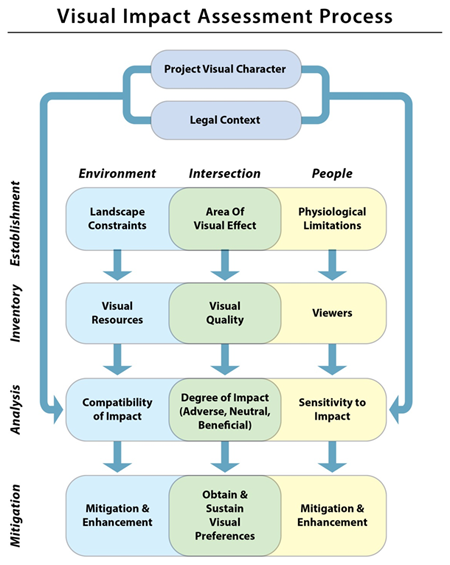
Updated Guidelines Offer Uniform, Comprehensive Instructions
for Conducting Effective Visual Impact Assessments
Transportation improvements can become a catalyst for improving the image of a community, but can also adversely affect community aesthetics. First impressions of the visual quality of a highway project can affect how a community is perceived by travelers, which may impact a community's social and economic vitality. The visual importance of our highways necessitates that visual impacts be adequately assessed and considered when a highway project is developed. Anticipating and responding appropriately to aesthetic impacts can avoid unnecessary delays in project delivery and help to enhance the visual experience of the project's neighbors and travelers.
Glossary
For a more thorough understanding of visual quality and VIAs, FHWA's guidelines define key terms:
Area of Visual Effect (AVE): The area of project visibility, determined by the physical constraints of the environment and the physiological limits of human sight. It is the sum of all viewsheds.
Neighbors: Those people who are adjacent to the highway and have views of the road.
Travelers: Those people who are using the highway and have views from the road.
Viewers: A project's affected population.
Viewsheds: What people can see in the environment; the result of the intersection between the physical constraints of the environment and the physiological limits of human perception.
- Dynamic viewshed: What travelers on the road see as they move through the landscape.
- Static viewshed: What neighbors of the road see from a stationary location.
Visual Resources: A project's affected environment.
The Federal Highway Administration's (FHWA) soon-to-be-released Guidelines for the Visual Impact Assessment of Highway Projects helps to incorporate aesthetics into planning processes, providing decisionmakers with the information they need to mitigate adverse impacts effectively while implementing concepts to enhance a community's existing visual quality. Updated from their 1980s predecessor, the new guidelines, now available online, are more efficient, accessible, and comprehensive than previous iterations and offer step-by-step instructions for conducting a Visual Impact Assessment (VIA).
New Guidelines Respond to Growing Need for Accessible, Uniform Process
The original VIA guidelines, Visual Impact Assessment for Highway Projects, were a response to the National Environmental Policy Act of 1970, which called for policies that incorporate aesthetics into Federal programs and the environmental documentation process. Many States adopted the suggested policies and procedures in the 1981 VIA document, but others adjusted the guidelines or developed their own procedures. As time passed, other Federal agencies developed original approaches to assess visual impacts. In the late 1980s, FHWA issued a set of clarifications and modifications to its original process.
During the 2000s, as the number of alternative assessment methods grew, FHWA and other parties interested in improving and standardizing VIA processes looked into the potential for developing a single process that all Federal agencies could use. Even though this collaborative effort focused on Federal VIA processes, there was still much uncertainty among practitioners regarding processes developed and utilized at the State level. In 2009, a consortium of State transportation agencies requested that the Transportation Research Board examine and make recommendations for improving VIA practices, which resulted in a study conducted by the National Cooperative Highway Research Program (NCHRP). The study, NCHRP Report 741: Evaluation of Methodologies for Visual Impact Assessments, evaluated the 1981 guidelines and other VIA methods to create a set of best practices for conducting VIAs. It included a survey of all 50 States, an extensive review of the literature, and an examination of several domestic and foreign case studies. Its findings, along with an additional survey of State Departments of Transportation (DOTs) and further research, provided the foundation for the updated VIA guidelines.
Quantifiable Assessments Provide More Accurate Analysis

The VIA process is the same regardless of project complexity. Each phase is based on the interaction between people and the environment. (Courtesy of FHWA)
Outlining a VIA helps practitioners to comply with laws, streamline the environmental review process, address conflicts before they happen, and plan and implement effective and efficient improvements. FHWA's VIA guidelines provide a foundation for conducting these studies that is accessible to agencies, regulators, and the public. The guidelines give practitioners the tools to address, describe, and quantify resources and impacts, using different levels of analysis based on context and setting.
The VIA process is carried out in four phases and is the same regardless of project complexity—the level of effort is tailored to fit each project. Each phase is based on the interaction between people and the environment:
- Establishment: Practitioners define the Area of Visual Effect (AVE), or the study area of the VIA (see the text box above for key term definitions). The AVE represents the sum of all viewsheds, considering landscape constraints and physiological limits of human sight.
- Inventory: Practitioners identify the affected environment and population and examine visual quality, or what people like or dislike seeing.
- Analysis: Practitioners then evaluate and analyze potential impacts that the project may have on the identified visual resources and viewers, determining the level of impact to be beneficial, adverse, or neutral.
- Mitigation: Practitioners define the project design's mitigation and enhancement. Established processes, such as Context Sensitive Solutions or similar State DOT guidance, can be helpful in coordinating with project designers and the public to identify effective and acceptable mitigation. The VIA guidelines provide examples of construction- and design-related mitigation measures which aid in identifying options and general effective measures.
Updates Include New Perspectives and Advancements in Science
The 2014 VIA guidelines incorporate updated and new information and research in order to improve efficiency and effectiveness for all users. Due to the changes to the new guidelines from the previous version, FHWA suggests reading through them before undertaking an assessment of a project's visual impacts.

Atmospheric conditions are one factor considered when conducting inventories and establishing viewsheds. Sometimes, atmospheric obstacles are episodic, like dust, fog, or precipitation that occur predictably either daily, weekly, or seasonally, altering the viewshed accordingly. (Courtesy of Tim Messick, ICF International)
The VIA process described in the guidelines includes new or expanded information on:
- Engaging the Public: Recommends engaging the public to a higher degree than earlier versions to achieve a better understanding of how people define visual quality and interpret changes to it.
- Offering Flexibility: Allows for different levels of documentation based on the scope, complexity, and challenges associated with the project.
- Incorporating Science: Incorporates substantial advancements in the science of the perception of visual quality and the techniques for evaluating impacts on it.
The VIA guidelines are an effective tool for evaluating existing conditions, minimizing project impacts, and planning and implementing aesthetic transportation improvements. The VIA guidelines help practitioners consider a highway project's total context and setting to determine what scope and level of analysis would best benefit the affected area and population and implement environmentally-streamlined, effective solutions. For the first time, these digitally-available guidelines will provide States and VIA authors with a comprehensive and uniform approach to conducting VIAs.
Contact Information
Adam Alexander
Office of Project Development and Environmental Review
Federal Highway Administration
(202) 366-1473
Adam.Alexander@dot.gov
Kreig Larson
Office of Project Development and Environmental Review
Federal Highway Administration
(202) 366-2056
Kreig.Larson@dot.gov
Look What's New!
- The U.S. Department of Transportation issued final guidance on implementing Section 1319 of the Moving Ahead for Progress in the 21st Century Act (MAP-21), which pertains to accelerated decisionmaking in environmental reviews. Click here for more information.
- The Obama Administration launched U.S. Climate Resilience Toolkit, a website that provides tools and resources to build climate resilience. To view the website, click here.
Successes in Stewardship is a Federal Highway Administration newsletter highlighting current environmental streamlining and stewardship practices from around the country. Click here to subscribe, or call (617) 494-3539 for more information.

